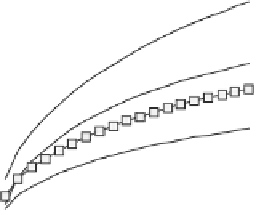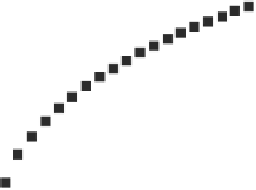Agriculture Reference
In-Depth Information
40.00
1x3 E. deglupta
1x9 E. deglupta
1x3 G. arborea
1x9 G. arborea
5x5 L. domesticum
10x10 L. domesticum
5x5 M. indica
10x10 M. indica
40.00
35.00
35.00
30.00
30.00
25.00
25.00
20.00
20.00
15.00
15.00
10.00
10.00
5.00
5.00
0.00
0.00
13579 1 3 5 7 9
13579 1 3 5 7 9
Simulation Time (Year)
Simulation Time (Year)
Fig 6.9
Simulated tree diameter of timber and non-timber trees at different hedgerow spacing
grown in
Imperata
grassland
hedgerow spacing treatments (Fig. 6.9). This could be attributed to lesser intra-
specific competition among the trees for both above- and below-ground resources.
6.3.2.2
Growth Performance and Control of
Imperata
Under Different
Hedgerow Spacing
During the first two years of tree growth, the growth performance of
Imperata
cylindrica
was not affected as evidenced by the high biomass production of
Imperata
(more than 2.0 kg m
−2
; Fig. 6.10). On the third year of tree growth, how-
ever,
Imperata
growth was greatly reduced, with
Imperata
biomass ranging from
0.12 to 0.13 kg m
−2
. Reduction of
Imperata
growth was greater under closer hedge-
row spacing than wider hedgerow spacing.
Comparing the control of
Imperata
growth under the two timber species simu-
lated, results showed that
G. arborea
hedgerows controlled the growth of
Imperata
on the 5th year under closer spacing treatment (1 × 3) and on the 8th year under
wider spacing treatment (1 × 9; Table 6.5). Under
E. deglupta
hedgerows, com-
plete suppression of
Imperata
growth occurred on the 6th year of tree growth
under closer spacing (1 × 3) and on the 14th year under wider spacing (1 × 9).
Comparing the growth performance of
Imperata
under fruit tree species, the
growth of
Imperata
was greatly suppressed on the 8th year under closer hedgerow
spacing (5 × 5) and on the 10th year under wider spacing (10 × 10; Table 6.5).
Overall, among the four tree species studies, control of
Imperata
growth was faster
when
G. arborea
trees were grown in
Imperata
areas. This may be attributed to the
large leaf size of
G. arborea
and the possibility of allelopathic effect of
G. arborea
roots.




















Search WWH ::

Custom Search